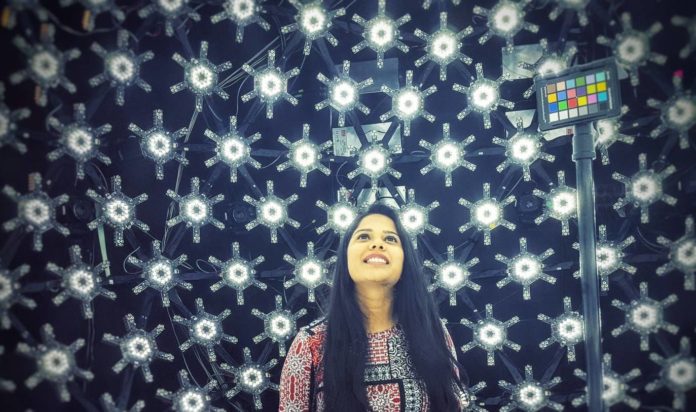Neuro Rehab VR
6913 Camp Bowie Blvd.
Suite 173
Fort Worth 76116
682-233-5646
www.neurorehabvr.com
A large, white tower-like structure welcomes visitors to Neurological Recovery Center on Camp Bowie Boulevard. From the outside, the boxy tower is at a standstill.
But inside, a lot of movements are taking place.
Various machines, treadmills and exercising tools are spread across a spacious central area. The clinic offers advanced, computer-assisted therapies to patients who have mobility disabilities.
A door-less exit on a corner opens up to a corridor. It leads to the back end of the building to a room with TVs, all attached to virtual reality headsets. Here, inside an enclosed cubicle, Veena Somareddy types away on computer codes most days.
Somareddy is the co-founder and president of Neuro Rehab VR. The company develops virtual and augmented reality software or games to simulate experiences and medical training.
Somareddy’s Indian parents wanted her to study medicine, become a doctor and help patients. But her interests did not match with her parents’.
She came to the U.S. to study game development and then started creating video games. However, even after studying in that field she found a way to fulfill her parents’ wishes. Somareddy is helping patients, just not as a doctor.
Neuro Rehab VR offers rehabilitation of patients with brain and spinal cord injuries. The company is one of the first and few in the health care industry that applies VR technology in the treatment of neurological diseases and injuries, such as stroke, spinal cord injury, traumatic brain injury, multiple sclerosis, cerebral palsy, Parkinson’s and others.
Somareddy tapped into the idea of neuroplasticity, a scientifically-proven phenomenon where the brain adapts to and undergoes changes continuously throughout an individual’s life, meaning, the brain can rewire, regrow and relearn things even after a brain injury.
Somareddy and her team have so far developed more than half a dozen games. The cost-effective and practical solution replaces real-life therapy sessions for recovering patients.
Patients can wear the VR headsets and choose to virtually perform a variety of tasks, from ducking a cannon to buying groceries. Their virtual actions result in real physical exercises that stimulate neurological development.
Neuro Rehab VR formed in March 2017 after Somareddy joined Bruce Conti and his clinic, Neurological Recovery Center, in a partnership. Conti, a commercial real estate developer, co-founded Neuro Rehab VR and is its biggest financial backer. Conti founded the Neurological Recovery Center in the old Target store at Cherry Lane and Interstate 30 in west Fort Worth after his son required extensive therapy following an illness.
After two years, Neuro Rehab VR is now attempting to step into the real world as a big player in the health care sector, whose future depends on technological advancement and innovation.
Earlier this year, the National Science Foundation awarded Neuro Rehab VR about $225,000 in a grant to use robotic-assisted, virtual reality-based therapy for stroke patients. The University of Texas at Arlington Research Institute is making flexible soft robotic gloves that will aid in rehabilitating stroke patients through virtual reality gaming. The glove will be combined with the virtual reality gaming to be developed by Neuro Rehab VR to enable stroke patients to engage in rehabilitation activities for regaining their hand function. The grant is part of the NSF’s Small Business Technology Transfer Fund and is aimed at helping technology startups commercialize products. UTARI is partnering with Neuro Rehab VR and the University of North Texas Health Science Center on the project.
And the entrepreneur community is taking notice. Neuro Rehab VR tied for third place in the SXSW Release It Pitch Competition in 2018 and received an Honorable Mention in Fast Company’s third annual World Changing Ideas Awards this year.
The company’s services are FDA approved. It is currently awaiting the results of a recently-conducted clinical trial.
Apart from its presence in hometown Fort Worth, Neuro Rehab VR also operates out of a clinic in Chicago.
The plan is to expand in about 20 to 25 clinics within this year, Somareddy said. Interests are also arising internationally from European and Asian markets.
To learn more about Neuro Rehab VR and its services, Fort Worth Business Press sat down with Somareddy for a Q&A.
FWBP: How did you come up with the idea of Neuro Rehab VR?
Somareddy: Because I already worked on creating VR in medical training and simulations. I could see how that could be transferred to the patients here. I cannot say that all the ideas just came out of me. Most of these ideas that we work with here, we talk to our patients, we talk to our therapist, and they give us input on what they need. This is how we’re building applications now.
How are your video games helping patients?
What we’re trying to do is help get back their limb function using the neuroplasticity of your brain, but also do your physical and cognitive therapy at the same time. So, for patients here, they won’t feel like they’re actually doing therapy when they’re immersed in the virtual world. They’re concentrating on this goal that they have to reach in the particular training exercising that they’re working on – it could be a range of motions for your upper extremity training, it could be your standing balance or core balance. So, they are going to therapy, but also, they’re having fun and its more engaging.
So, they forget about what they cannot do because they can’t really see their actual limbs. And they end up doing a lot more, moving as they’ve never moved before. They forget about the reality for the amount of time they’re in VR.
What kind of outcome should patients expect after coming to Neuro Rehab VR?
There’s so much that could happen in a brain injury. If your parts of brain cells die because there’s no oxygen, you cannot use that functionality for which that part of the brain was responsible for.
What you can do is, you know, the brain is plastic, so you relearn and make sure your healthy parts of the brain take over the functionalities of those damaged areas. It’s like rerouting through neural pathways.
Pretty much like, how when you were a kid, you were learning everything new and everything was new for you while you are forming those pathways.
It’s kind of what you do here. A lot of patients come here to relearn how to walk, relearn to do an everyday living activity, like brushing your teeth.
So we create some of our scenarios to recreate these everyday tasks. So, you can learn that in the virtual world. There’s a lot of research that shows that there’s a very good training transfer from the virtual world to the real world. Because you’re using your limbs, you’re using muscle memories and also your mind.
How challenging is it to get funding for new ideas and run a business, simultaneously?
Very challenging. I can’t say how hard [it’s been], obviously. We have a small team and we’re trying to do a lot, at the same time. And sometimes, it is very challenging to think about what to focus on, what’s important? Our goal is making sure we create things that the patients would use, the therapists would use, and they’re providing value. Then, there’s this piece, how do we make money? So, we have to balance both and make sure that we’re hitting both targets at the same time. Yeah, it’s always hard.
What is the work dynamic between your company and Neurological Recovery Center?
The therapists, now at this point, know how all the applications work and how the training segments are. They pick what would be helpful for their patients. So, they come in with the patients. We, in the end, are a technology company. The clinic [Neurological Recovery Center] works with us, or partners with us.
Do you believe the company has survived the startup phase and now can be considered a solid business?
I don’t know. Probably. Hopefully. I think because VR is so new, a lot of therapists don’t know about it and we have to explain from the beginning what is VR. And then come to the point of how we can use it in physical therapy.
As we are going ahead, we are finding a lot of therapists who already know how VR works and what it is. And they understand the benefits, but we still have to educate them about how it can be used.
There is an advantage for us because we have this partnership with the clinic and have this team who have engineering backgrounds and PhDs. I think we’re ahead of other VR companies just because we have a whole range – about eight applications, which target different parts of your body and the brain, a whole suite that nobody else has.
Besides the expansion plans, what other goals does the company has?
We concentrated on neuro patients, just because we have access to them in this clinic. But we want to create things for kids on the autism spectrum, for occupational therapy and also, maybe, sports training. That kind of how we want to expand to other areas of therapies, too.
Do you think a technology company can thrive in Fort Worth?
There are such amazing things happening in the DFW area. You don’t really have to be in Silicon Valley to be a tech company now. I think the landscape is changing.
It’s a really great place to start a company here in the area or in Texas. Because we have the UT schools, we have the University of Dallas, we have UT-Arlington; we have health care institutes, like the University of North Texas Health Science Center, UT Southwestern. It’s a really good place to be for a startup, especially for a health care startup.
Big Data & AI Conference
Somareddy will be sharing more on artificial intelligence, virtual environments and patient outcomes at the inaugural Big Data & AI Conference. She is one of the speakers at the event.
Other speakers include experts from complies like, Google, IBM, Microsoft and Verizon.
The event takes place from June 27 to June 29 in Addison.
More information: https://bigdataaiconference.com
For more on Conti and how he developed the rehab center:
www.fortworthbusiness.com/news/the-right-direction-developer-opens-rehab-center-for-brain-spinal/article_a8c5dd06-3253-11e5-bac8-835c26768e85.html








